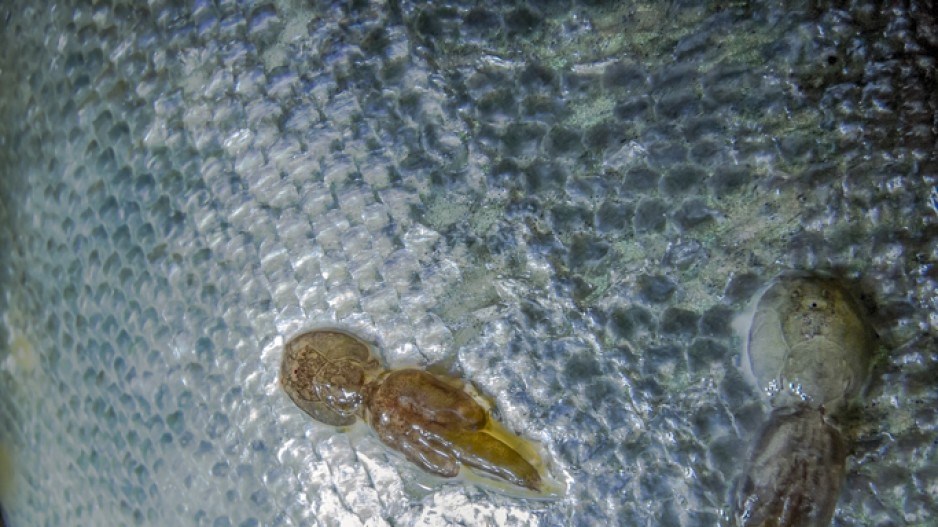Sea lice on young pink and chum salmon in the Discovery Islands region dropped 96 per cent after salmon farms were removed in 2020, a new paper co-authored by independent researcher Alexandra Morton concludes.
Morton has long argued that open-net salmon farms pose a risk to wild salmon because they can amplify diseases and pests, like sea lice, which could have a deleterious effect on wild fish.
In research published this week in the Canadian Journal of Fisheries and Aquatic Sciences, Morton, of the Raincoast Research Society, and co-author Richard Routledge (professor emeritus of statistics at Simon Fraser University) published findings of sea lice counting done on wild salmon after open-net salmon farms in the Discovery Islands were removed, by order of the federal minister of Fisheries and Oceans.
Whereas there were eight salmon farms in the area studied in 2020, only one was left by 2022.
“This staged removal of farm salmon provided a uniquely valuable opportunity to monitor the abundance of lice on wild salmon as the farms were depopulated,” Morton and Routledge write.
Between 2020 and 2022, Morton and Routledge counted sea lice on 1,627 pink and chum salmon passing through the Discovery Islands region where salmon farms had been removed.
“The overall average number of lice …per fish declined: 5.15 in 2020, 0.302 in 2021 and 0.198 in 2022 – a 96% decline from 2020 to 2022,” the paper states.
“By contrast, the 22-year time series for louse abundance on pink and chum salmon in the Broughton Archipelago, British Columbia, 50km away, showed no similar decline in 2020-2022.”
Sea lice are naturally occurring and can get passed back and forth between wild and farmed salmon in open-net cases.
Ocean temperatures and salinity can contribute to sea lice population fluctuations. But the Morton-Routledge paper says that there was “no statistically significant association between salinity and lice abundance.”
As for temperatures, the paper notes: “While significant association exists between temperature and sea lice abundance… it does not account for the full extent of the decline in 2020 - 2022, which remains significant.”
“The results of this study demonstrate that the depopulation of the salmon farms in the Discovery Islands area was accompanied by a substantial and highly significant decline in sea lice infection on juvenile pink and chum salmon migrating through the area,” the paper concludes.
“This decline cannot be attributed to salinity and temperature fluctuations that occurred in 2020 - 2022 for the following reasons: (i) Temperature could account for only a portion of the decline, with salinity not even statistically significant, and (ii) Whatever influence these variables may have had on sea lice, was not observed in the neighbouring region to the north.”
The BC Salmon Farmers Association is questioning the study’s methodology, and points to annual sea lice counting done for the industry by independent researchers that suggest there has been little change in sea lice numbers on wild salmon over the study period that could be attributed to salmon farms.
While the association acknowledges there was a noticeable decrease in sea lice on wild fish in 2022 in the region in question, it notes that this was the case both before and after the fish would have migrated past open-net salmon farms.
The association says the sampling locations in the Morton-Routledge study are “inconsistent, and the paper does not break the sampling into pre-exposure, exposure, and post-exposure areas to determine if sea lice levels change when fish pass farms.”
“Professional biologists have consistently measured the abundance of sea lice on wild juvenile salmon at the same locations for the past seven years in the Discovery Islands region,” Brian Kingzett, executive director of the BC Salmon Farmers Association, said in response to the Morton-Routledge paper.
“The data shows that the sea lice abundance on juvenile wild salmon in 2022 was about 50 per cent less than in 2020, however, that was the case both before they reached salmon farms and after they passed by salmon farms.
“Furthermore, 2022 sea lice levels were similar to 2017 and 2018 when all farms were active in the Discovery Islands region.
“Activists have changed sampling locations each year and selected just two data points to try and support their narrative while ignoring long-term trends from data collected all along the coast.
"We now have seven years of independent sea lice monitoring demonstrating that sea lice levels have been consistently low with most out-migrating juvenile salmon while salmon farms were operating and after they were removed.”



